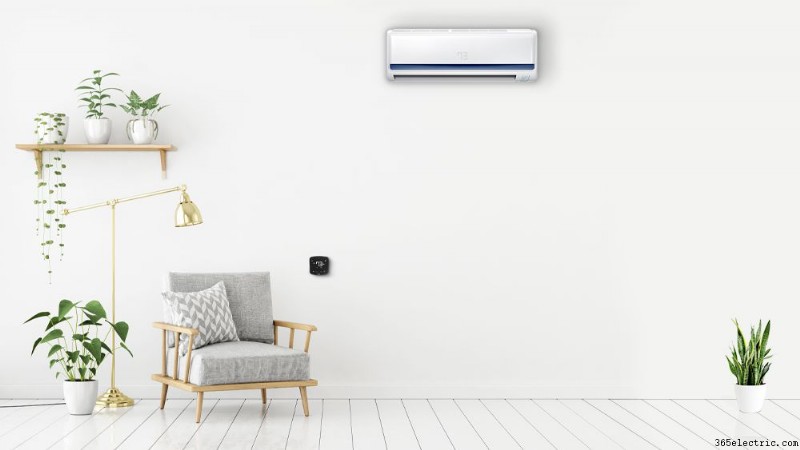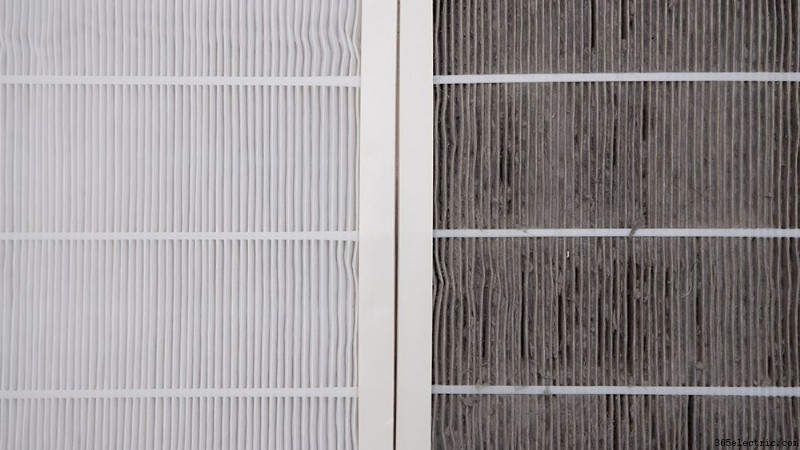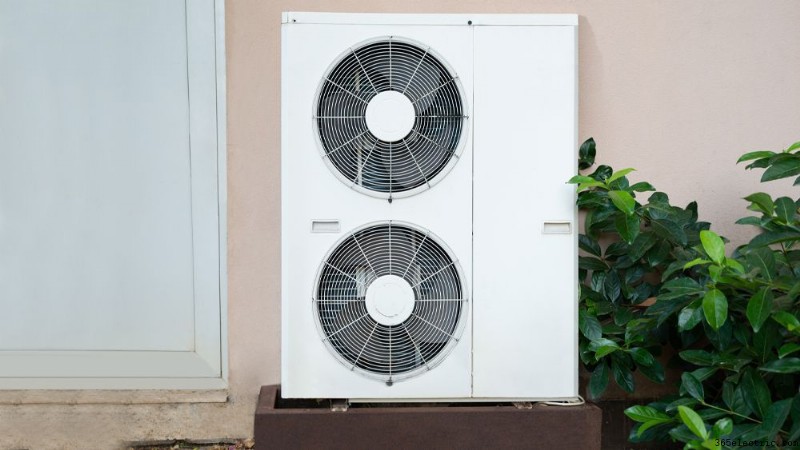
Sua dependência do ar condicionado aumenta à medida que as temperaturas continuam a subir. Chegar em casa depois de um longo dia de trabalho e descobrir que seu ar condicionado o decepcionou é frustrante no calor escaldante do verão. Você pode descobrir que seu ar condicionado está soprando ar quente em um ato ousado de rebelião.
Quente e suado, você está desesperado para encontrar alguma solução para seus problemas. Não se preocupe, abaixo você encontrará 12 possíveis razões pelas quais seu ar condicionado está soprando ar quente e suas soluções.
Como funciona um ar condicionado?
Antes de iniciar a solução de problemas, você precisa saber como funciona um ar condicionado.
Uma unidade AC tem três componentes principais:uma serpentina do condensador, uma serpentina do evaporador e um compressor. Ele também usa um agente químico ou de resfriamento conhecido como refrigerante, que pode mudar de líquido para gás rapidamente e vice-versa. A serpentina do evaporador contém o refrigerante frio e gasoso. O evaporador sopra ar interno na bobina do evaporador frio, resfriando o ar devido à troca de calor. Em seguida, o ar refrigerado é soprado de volta para o seu quarto.
O refrigerante é agora enviado para o compressor, onde é convertido em um líquido de alta temperatura. Em seguida, ele é enviado para as bobinas do condensador e resfriado por ventiladores que sopram sobre ele. O ar quente é transferido para o exterior e o refrigerante é arrefecido. Em seguida, o refrigerante líquido frio passa por uma válvula de expansão, onde é convertido em gás frio e enviado para a serpentina do evaporador.
É importante entender os componentes e o processo, porque se houver um problema com qualquer uma dessas partes do ciclo, seu AC soprará ar quente.
12 razões pelas quais seu ar-condicionado está soprando ar quente
Se você está passando por uma situação semelhante, primeiro dê uma olhada neste artigo para aprender sobre diferentes maneiras de se refrescar sem um AC. Porque resolver o problema pode demorar um pouco e você não gostaria de fazer sua casa parecer um deserto nesse meio tempo.
Pode haver muitas razões por trás do seu ar quente soprando AC. Aqui estão 12 das razões mais comuns pelas quais seu aparelho de ar condicionado está traindo você:
1. Termostato calibrado incorretamente

Às vezes, o ar condicionado está soprando ar quente porque foi ajustado incorretamente.
Por exemplo, se o seu ventilador estiver ligado, ele está soprando ar o tempo todo, mesmo quando não está esfriando. Assim, ele sopra ar quente entre os ciclos de resfriamento. Outro motivo pode ser que você tenha acidentalmente definido seu AC no modo de aquecimento. Além disso, verifique se o setpoint está muito alto. Outra possibilidade é que seu termostato esteja calibrado incorretamente e não possa definir a temperatura ambiente desejada. Você também deve verificar as baterias do seu termostato ou controlador de CA inteligente.
Solução:
Verifique seu termostato e veja se o ventilador está definido para ON. Se sim, altere-o para AUTO, para que funcione apenas durante os ciclos de resfriamento.
Você também deve verificar novamente se o termostato não está no modo de aquecimento. Às vezes, termostatos antigos do tipo dial são calibrados incorretamente. Um termostato mal calibrado lê a temperatura incorretamente. Como não consegue manter a temperatura correta, você deve reajustar o termostato com frequência. Se você suspeitar que seu termostato está calibrado incorretamente, você pode substituí-lo ou recalibrar por um profissional.
Para condicionadores de ar sem dutos, como mini-splits, você também deve considerar investir em controladores de CA inteligentes como Cielo Breez Plus para manter a temperatura dentro de sua casa consistente e precisa. Se você tiver um ar condicionado central, considere comprar um termostato inteligente. Esses dispositivos inteligentes tornam sua vida muito conveniente com seus recursos inteligentes e você não precisa se preocupar em alterar as configurações manualmente.
2. As aberturas de retorno estão fechadas
Outra razão pela qual seu ar condicionado está soprando ar quente é que você pode ter fechado os registros de retorno superiores. Como o ar quente sobe e o ar frio desce, fechar os registros de retorno superiores significa que o ar quente permanecerá dentro de sua sala e não será enviado para a unidade HVAC para resfriamento.
Se você tiver um ar condicionado central, pode ter aberto as aberturas de retorno inferiores no inverno e fechado as aberturas de retorno superiores. Há uma chance de você ter esquecido de reabrir as aberturas de retorno. Às vezes, móveis, sujeira e detritos também podem bloquear as aberturas de retorno.
Solução:
Caminhe pela sua casa e verifique se todos os registros de retorno estão abertos. Se você está tendo problemas para descobrir se suas aberturas de retorno estão abertas, segure um lenço de papel a quinze centímetros de distância. Se seus registros de retorno estiverem abertos, você sentirá o tecido sendo puxado para dentro do respiradouro de retorno.
3. Vazamento de refrigerante
O refrigerante é o fluido dentro do seu AC que absorve o calor do ar e resfria o seu quarto. Se você tiver um vazamento de refrigerante, sua unidade ficará gradualmente com pouco agente de refrigeração. Como resultado, o fluido refrigerante restante pode não ser suficiente para resfriar seu ambiente.
Níveis baixos de fluido refrigerante também podem fazer com que o ar condicionado sopre ar quente. Se o seu AC não estiver resfriando adequadamente, um vazamento de refrigerante é uma das primeiras coisas a verificar.
Você pode detectar um vazamento de refrigerante observando as bobinas do evaporador e do condensador. Embora eles devam estar frios ao toque, eles não devem ser congelados. Outro sinal revelador de um vazamento de refrigerante são ruídos sibilantes e contas de energia inexplicavelmente altas.
Solução:
Nunca tente consertar um vazamento de refrigerante por conta própria. Um vazamento de refrigerante é um perigo para a saúde e segurança. Ligue para o seu técnico de HVAC imediatamente assim que suspeitar de um vazamento de refrigerante.
4. Filtros de ar sujo

Um filtro de ar sujo é outro motivo comum por trás de um ar quente soprando AC. Filtros de ar sujos causam problemas de fluxo de ar em todo o sistema e podem superaquecer o motor do ventilador. Eles também aumentam o uso de energia, pois forçam sua unidade HVAC a trabalhar com uma configuração de energia mais alta. Portanto, se o seu AC estiver soprando ar quente, fique atento aos filtros de ar sujos.
Normalmente, uma inspeção visual é mais que suficiente para ver se seus filtros de ar estão sujos. Remova os filtros de ar e segure-os. Se você puder ver através deles, seus filtros de ar estão limpos. Se estiverem entupidos com sujeira, eles precisam ser limpos ou substituídos.
Solução:
Em média, você deve limpar seus filtros de ar a cada duas semanas e substituí-los a cada 3-4 meses. Primeiro, limpe os filtros de ar lavando-os com água e sabão. Em seguida, deixe-os secar ao ar ou use um pano macio e seco para remover a umidade.
Aqui está um guia completo para a limpeza do seu ar condicionado, para que você esteja sempre em dia com a manutenção.
5. Bobinas do evaporador sujas
Uma serpentina do evaporador mantém o refrigerante refrigerado dentro. Este refrigerante refrigerado na serpentina do evaporador remove o calor do seu quarto quando o ar do ventilador se move sobre ele. Um subproduto natural deste processo é a condensação.
Quando há umidade nas bobinas, elas ficam mais propensas a ficar sujas porque as partículas de poeira grudam nelas. Como a serpentina do evaporador funciona por absorção, ela perde sua capacidade de resfriamento se coberta de poeira. Portanto, as bobinas do evaporador sujas podem fazer com que o ar condicionado sopre ar quente.
A dirty evaporator coil also causes more wear and tear on your HVAC unit and can reduce its lifespan. Debris on evaporator coils can also lead to ice buildup.
Solution:
Turn off power to your AC unit and, to be on the safe side, turn off the circuit breaker as well. Locate the indoor access panel and unscrew it. Look at the evaporator coils and see if there is any dust or debris on them.
On average, you should be cleaning your evaporator coils every two months. Use a soft-bristled brush to remove any dust particles or debris. Use a coil comb to clean the area between the coil fins, taking great care not to bend the fins. If you do see any bent fins, gently straighten them with a fin comb. You can also use other methods to clean evaporator coils, such as the compressed air technique.
6. Frozen Evaporator Coils
When the evaporator coil removes heat from the air to chill your room, it leads to condensation. Air conditioners have a condensate drain to remove this moisture from the system. When too much water collects on the evaporator coil, it can freeze over. A frozen evaporator coil prevents heat transfer which can lead to your home AC blowing warm air.
Solution:
To check if you have frozen evaporator coils first shut off power to your AC unit. For extra safety, also turn off the circuit breaker. Then open the indoor access panel and check for any frost or ice on the evaporator coil. To find out where the access panel is located, consult your AC’s instruction manual, then remove any screws or fasteners to gain entry to the access panel.
If you see any frost or ice on your evaporator coils, let them thaw. Do not turn the AC on until any frost has melted completely.
If letting them thaw in the open air is taking too much time, you can use a hairdryer over the coils at the lowest setting. Keep the hairdryer at a safe distance from the evaporator coils, so you don’t damage them.
If the problem reoccurs, you will have to contact a seasoned HVAC professional.
7. Dirty Condenser Coils
Condenser coils are located inside your AC’s outdoor unit. The condenser’s job is to release the hot air from your room outside. Since the condenser coils are in the outside unit, they gather a lot of dust and debris and become clogged with leaves and small branches.
If your condenser coils are dirty, it may result in AC blowing hot air because it cannot effectively expel heat outside.
Solution:
Turn off your AC unit and the circuit breaker. Then remove the condenser cover. Inside, you will see a cage. Unscrew the cage and remove it. After you have removed the cage, you will see the condenser coils. Inspect to see if you find any leaves, dust, or debris.
Manually remove any leaves or small branches. Then, use a soft-bristled brush to clean condenser coils.
8. Lack of Electricity to the Outside Unit
Both your indoor and outdoor AC units need electricity to run. If electricity to your outdoor unit is interrupted, your indoor unit will blow warm air since the outdoor unit can no longer release heat outside. Therefore, if your home AC is blowing warm air, you should check whether the outdoor unit is getting power.
Solution:
Locate your electrical panel and check your circuit breaker to see if it has tripped. Also, keep an eye out for any blown fuses. You can identify a blown fuse using these steps:
- Turn off electrical power to the unit.
- Remove the fuse from its holder.
- Look at the fuse wire. If you can see a visible gap or a dark smear in the glass, you have a blown fuse.
Use a multimeter if you cannot visually confirm whether the fuse is blown,
If the circuit breaker has tripped, first turn it off completely, then turn it back on. Replace any blown fuses. However, if the fuse keeps blowing repeatedly or the circuit breaker keeps tripping, it is a sign that something more is wrong. In that case, consult a certified electrician.
9. Fan Problems

The fan in your outdoor unit is responsible for transferring indoor heat outside your home. If this fan is damaged, proper heat transfer does not take place. Lack of suitable heat transfer can then lead to your AC blowing warm air.
Solution:
Fan problems can be due to a wiring issue or dirt and debris stuck in the fan. Turn off the power and remove the outside cover. Manually remove any dust you may see.
If your fan problems do not resolve after cleaning, consult a certified HVAC professional.
10. Clogged Drainpipe
The AC condensate drain removes water collected during the cooling process. This water is collected in the drain pan and then flows into the drainpipe. Over time the drainpipe can become clogged with debris and mold. When this happens, water can overflow and damage your aircon unit.
Solution:
Signs of a clogged drain line include water damage near your indoor unit and a musty, moldy scent. Some clogs can be removed by hand while wearing protective gloves. For deeper clogs, use a wet dry vacuum. Attach it to the end of the drainpipe and seal it securely with duct tape. Turn the vacuum on to suck any clogs.
For stubborn clogs, prepare a mixture of one cup bleach and one cup water. Pour it down the drainpipe to dissolve any debris. After cleaning the drainpipe, empty the drain pan and wipe it down. Make sure there is no moisture left; otherwise, it can lead to mold growth.
11. Leaking Ducts
If none of the above-mentioned reasons sort out your problem and you’re still wondering why your AC is blowing warm air, you may want to take a look at your ducts.
There may be a leak in your ductwork caused by rodents or poor installation. If there are holes in the ducts, cold air will not reach you and may get lost on its way. Leaking ducts can cause you to lose roughly 20 to 30 percent of conditioned air, resulting in insufficient cooling and high energy costs.
Solution:
Use mastic sealant or metal tape to seal any air leaks. Further, seal vents and registers where they meet any surface, such as the ceiling. However, since most of your ductwork is hidden, if you suspect a leak deep inside, you will have to contact a professional to locate the leak and fix it.
Faulty ducts are frequently the reason behind your air conditioner blowing hot air; therefore, it is a good idea to conduct proper inspection after some time.
12. Faulty Compressor
The compressor, also considered the heart of your HVAC unit, handles refrigerant circulation within the unit. If the compressor isn’t working properly, your air conditioning unit will not cool as it should.
Signs of compressor failure include weak or warm airflow, loud banging noises, etc. A faulty compressor is one of the main reasons why your AC blows warm air.
Solution:
Repairing an AC compressor is not doable for the average layperson. Consult a certified HVAC technician who will diagnose the problem and decide whether it is fixable. Repairing AC compressors is often cost-ineffective and sometimes replacing the whole unit is cheaper. You should carry out regular maintenance of your AC to prevent costly repairs such as compressor failure.
Your AC blowing warm air can ruin your whole mood and day, especially if you live in an area prone to heat waves. However, with these troubleshooting tips at your disposal, you are sure to remain cool and relaxed throughout the summers and beat the heat.



